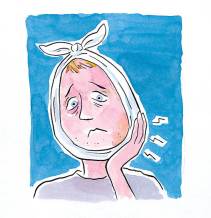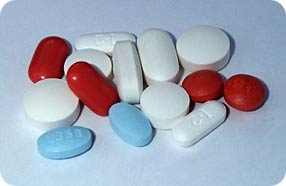 Management of post surgical tooth extraction pain
Management of post surgical tooth extraction pain
All patients should expect a certain amount of tooth extraction pain after a surgical dental extraction. Therefore, it is important for the dental surgeon to discuss this issue carefully with each patient before discharging them from the office. The surgeon will have to help the patient to have a realistic expectation of what type of pain that may occur and the intensity of the pain as well.
There are three characteristic of pain that occurs for a tooth extraction.
First, the tooth extraction pain is usually not severe and can be managed in most patients with mild analgesics.
Second, the peak tooth extraction pain experience occurs about 12 hours after the tooth extraction and slowly disappears after that.
Thirdly, significant pain from tooth extraction sites rarely persist longer than two days after the tooth extraction surgery.
The prescription of analgesics (pain medication) will be based on those 3 types of pain experienced by the patient.
 When to take the analgesic medication?
When to take the analgesic medication?
The first dose of analgesic medication should be taken before the affect of the local anesthetic injection wears off. If this is done, the patient is less likely to experience intense, sharp onset of post surgical tooth extraction pain after the loss of effect of the local anesthesia. If the patient waits to take the first dose of analgesic until the local anesthetic effect has disappeared, it may take up to 90 minutes before the analgesic becomes effective. During this time the patient will most likely become impatient and take additional medication that will increase the risk of nausea and vomiting.
Dosages of oral analgesic medications (pain medication that are taken by swallowing with water)
- Mild pain situations
Ibuprofen -Â 400-800 mg 4 hourly
Acetaminophen -Â 500-1000 mg 4 hourly
- Moderate pain situations
Codeine -Â 15-60 mg
Hydrocodone – Â 5-10 mg
- Severe pain situations
Oxycodone -Â 2.5-10 mg
Promotion of healing after surgical tooth extraction
Surgical healing of the tooth extraction site takes place immediately after the surgery itself. There are some simple guidelines that a patient should follow to promote faster healing. Firstly having a good diet and secondly is maintaining a good oral hygiene environment in the mouth itself.
 Diet after a surgical tooth extraction
Diet after a surgical tooth extraction
Patients who have had a tooth extraction may avoid eating because of local pain or fear of pain when eating. Therefore, certain diet instruction should and will be given by the dental surgeon.
Mainly, a high-calorie, high-volume liquid diet is best for the first 12 to 24 hours after the tooth extraction. Adequate intake of fluids is a must, usually at least 2 liters during the first 24 hours. The fluids can be juices, milk water or any other beverage which appeals to the patient.
The food chosen for ingestion for the first 12 hours should be soft and cool. Cool and cold foods like ice cream and milk shakes help keep the tooth extraction area comfortable and reduce the post surgical inflammation of the wound.
Solid foods that require a lot of chewing like corn or bread tends to cause local trauma or re initiate bleeding at the tooth extraction site.
Spicy food should also definitely be avoided as it causes a painful stinging sensation at the tooth extraction site. Imagine, its like putting salt on a an open wound.
Patients are advised to go back to their normal diet as soon as they fell they can. This of course because a diet only consisting of ice cream and milk shakes can be very detrimental to our health and oral hygiene. A period of 1 week should be the maximum time limit for such a diet.
Patients who are diabetic should be encouraged to go back to their normal insulin and caloric intake as soon as possible.
Oral hygiene care after a surgical tooth extraction
Patients are advised that keeping the teeth and mouth reasonably clean results in a more rapid healing of their surgical wounds. Postoperative on the day of the tooth extraction surgery, patients may gently brush the teeth that are away from the area of surgery in the usual fashion. Patients should avoid brushing the teeth immediately next to the surgical tooth extraction site. This is to prevent a new bleeding episode, avoid disturbing the sutures and avoid feeling pain.
On the next day, The patient should begin gentle rinses with warm water. The water should be warm but not hot enough to burn the tissues. Most patients can resume preoperative oral hygiene methods by the third or fourth day after surgery. Dental floss should be used in the usual fashion on teeth in front of the tooth extraction site as soon as the patient is sufficiently comfortable.
If oral hygiene is likely to be difficult after extractions in multiple areas of the mouth, mouth rinse agents such as dilute hydrogen peroxide may be used. Rinsing 3 to 4 times a day for approximately 1 week after the tooth extraction surgery may result in more rapid healing.
Pingback: Tweets that mention Management of pain and promotion of healing after a tooth extraction | Intelligent Dental -- Topsy.com
Pingback: Management of bleeding after a tooth extraction | Intelligent Dental
found your site on del.icio.us today and really liked it.. i bookmarked it and will be back to check it out some more later
Thanks forex robot , will be posting 2 more articles on extraction, be sure to read it 🙂
Great, I never knew this, thanks.
Pingback: How do baby's teeth grow? | Intelligent Dental
Pingback: How to Sooth a Toothache of a Teething Baby | Intelligent Dental